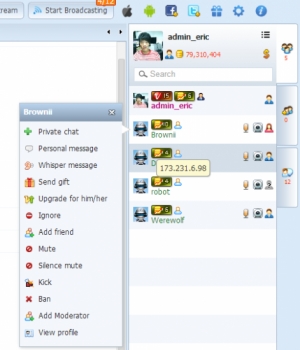
AOL did more for the WaReZ scene than anyone else in the mid-to-late 90s.
#123 FLASH CHAT HACK DOWNLOAD DOWNLOAD#
You'd do this for a bunch of stuff and then when going to bed, let AOL's download manager download everything overnight. I'd then send `/send 400-403` in the chat and in a few minutes I'd have four forwarded emails containing a portion of an archive.

If I were looking for PhotoShop, I might see something like: Sending the `/list` command in chat would result in one or more emails with lists of software, usually split up to reduce file size. Then the progz/bots, called Mass Mailers (MMers) would sit in a private chat and wait for commands. Warez groups would recruit people for positions likw uploaders with strong connections who would just send tons of mail with attachments (to themselves I think). So when you forwarded that email to someone, the download was just a pointer to the original location on their servers. To expand on this a bit, when you mailed an attachment on AOL, it would upload and be hosted on their servers. It was a remarkably simple solution to a hosting problem, and the folks who organized it all will never get enough credit for their contribution toward creating a generation of graphics experts, for example, who couldn't afford the crazy prices of Photoshop or 3ds Max, but were able to use pirated copies to develop those skills and turn them into careers.

They effectively hosted the warez scene throughout the 90s, until residential broadband became available and 10-100mbps was common in places like Sweden and Singapore, at which point the scene shifted to IRC and self-hosted top sites (i.e. It took AOL a long time to catch on to this, and even then, they couldn't keep up with the sheer number of fake accounts being created - or, as the article points out, accounts made with phished credit cards, of which there were hundreds of thousands floating around and a never-ending supply of new ones as AOL's userbase grew.
#123 FLASH CHAT HACK DOWNLOAD SERIES#
Then you would type another command into the chat to request a specific file or release, and the bot would forward you a series of emails with <1.4MB attachments (the maximum size at the time), already stored on AOL servers and ready to download at whatever speed your modem could handle. The difference being that the AOL bots would email a list of available content, which could be a paginated list across multiple emails, or results for a specific search query. Similar to IRC channels with bots that provided lists of available content and used DCC to transfer compressed files in small chunks - these were still the days of 9600-56k, so transfers larger than floppies were often doomed to fail - AOL private rooms would be filled with bots that would respond to requests and send files.

I think the one of the most interesting and overlooked stories about the AOL era, is how the warez scene used bots and AOL's mail system to host every piece of pirated content for years.


 0 kommentar(er)
0 kommentar(er)
